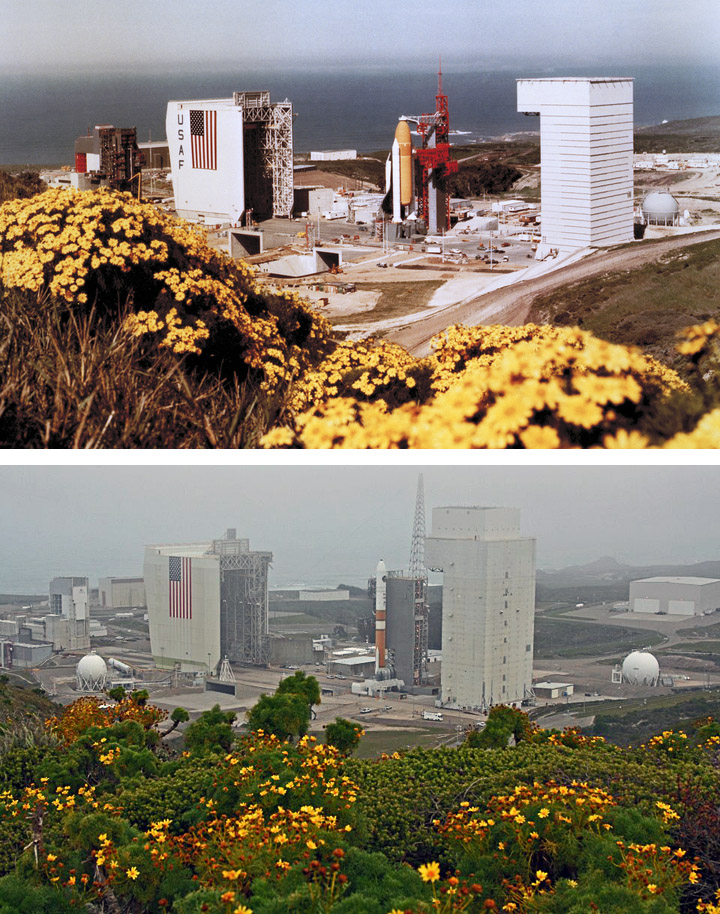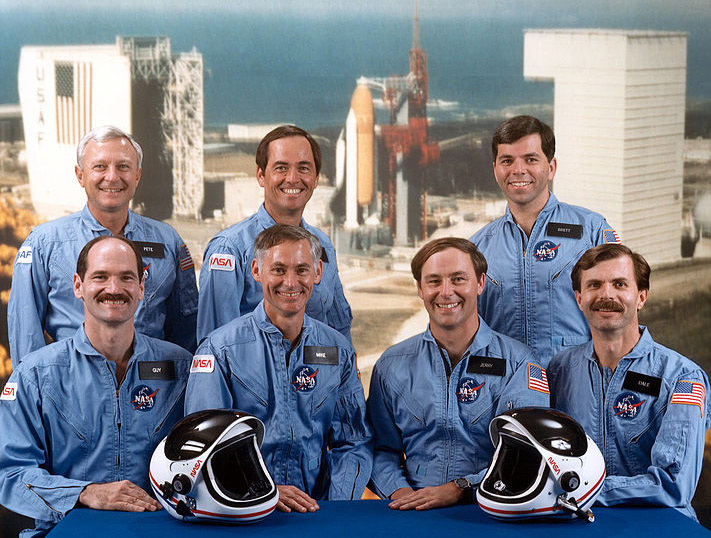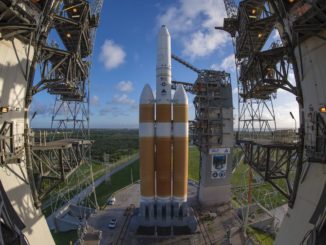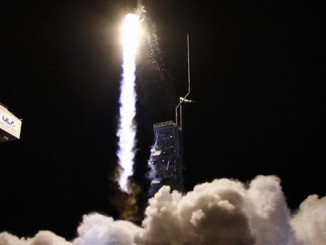
It was 1986 and the U.S. Air Force was on the cusp of something unprecedented in human spaceflight — launching a space shuttle crew from California and paving the way for people to fly true polar missions.
Space Launch Complex 6, along the rugged terrain on the southern expanse of Vandenberg Air Force Base, is a sprawling pad originally built for the military’s Manned Orbiting Laboratory reconnaissance space station in the 1960s before that was cancelled.
The 1980s dawned with America’s new space shuttle and the promise that it could carry all of the nation’s satellites to orbit. The Air Force breathed new life into SLC-6, or Slick 6, for military launches to polar orbit from the West Coast, a steadfast requirement for secret surveillance satellites.
NASA had the Kennedy Space Center for the hub of shuttle operations to ascend eastward for equatorial orbits, but Vandenberg offered prime real estate to fly the orbiter southward on a path that the electro-optical telescopes for spying on adversaries needed to reach global orbits, looping from pole-to-pole.
In February 1985, NASA and the Pentagon announced the crew of STS-62A — the maiden shuttle flight from Vandenberg. Discovery would be commanded by four-time shuttle astronaut Bob Crippen, with pilot Guy Gardner and mission specialists Mike Mullane, Jerry Ross and Dale Gardner. They would be joined by payload specialists Pete Aldridge, the covert National Reconnaissance Office director and under secretary of the Air Force, and Brett Watterson, a military spaceflight engineer.
After repeated delays in construction and numerous technical problems, launch was targeted for the summer of 1986. The prototype shuttle Enterprise had performed a series of “fit checks” and practice assembly activities in 1985, even perching atop SLC-6 for a photo op.

See our photo galleries:
Inside shuttle hangar | Road trip to pad | Arrival at SLC-6 | Shuttle stacked on pad | Nighttime views | Inside launch control room | Final look at West Coast shuttle
Today, three decades later, those photos and the fading memories that embrace them are the tangible proof of the unfulfilled space shuttle era even existed at Vandenberg.
On Jan. 28, 1986, while the Vandenberg astronauts were training with one of their payloads at a national laboratory in New Mexico, the crew paused to watch the space shuttle Challenger launch from the Kennedy Space Center on the program’s 25th mission and the first with a private citizen aboard — school teacher Christa McAuliffe.
“We were getting briefings on some of the instruments we anticipated operating and the theories behind them and the uses of the data,” recalls Jerry Ross, one of the astronauts assigned to Vandenberg’s first shuttle mission.
“We had a TV on over in the corner of the room, sound turned down, just monitoring the status of the launch. At about the time of the accident, Dale Gardner noticed something on the TV and he said ‘look at that’ and we all turned around and at about the same instant we saw the accident occur.
“I think all of us had totally different responses of what we were seeing and what we were trying to make sense out of…We very quickly understood what had happened and the severity of the accident. So we cancelled what we were doing and made preparations to return to Houston as quickly as we could.”
The Challenger accident, triggered by cold weather that allowed hot gas to escape by the faulty rubber O-ring seal design in the right-hand solid rocket booster aft joint, led to cascading changes for the space program.
“All of the flight assignments were negated. The whole flight manifest was zeroed out, basically, and no one had a flight assignment at that point,” Ross said in a recent telephone interview.
The military and civilian programs would be de-coupled, shuttle flights for the Air Force were phased out, the Pentagon ordered creation of expendable rockets to launch its satellites — the Delta 2 to construct the Global Positioning System, the Atlas 2 for communications satellites and the Titan 4 for large surveillance spacecraft, and Vandenberg’s SLC-6 would be mothballed.

“I think, at the end of the day, it was the right thing to do, to separate the Air Force’s payloads from the shuttle and let them go back to being more autonomous and be more in control of their own destiny in terms of when they needed to get vehicles into space,” Ross said.
“At that point, we didn’t have that much experience yet on the space shuttle, but people were starting to think it was a commercial airliner-type of operation. I don’t think we, the crew members, ever felt that way. But that’s what our management was treating it as. So I think that was a big problem and that’s one of the reasons we got to where we were.”
Ross had looked forward to 62A, its high orbit, unique tilt relative to the equator and paving new ground.
“I think we were supposed to go to an apogee of around 340 nautical miles. So we would have gotten to see a much different perspective on the Earth from that altitude. Certainly going to a 72-degree inclination orbit would have given us the chance to fly over, basically, all the inhabited parts of the world, which would have been the first time ever for that. That would have been pretty cool. And, of course, getting to do anything for the first time, flying out of Vandenberg for the first time, overflying the icy parts of the world, would have been very cool, no doubt about it.”

62A was a Defense Department mission, albeit not a classified one, to launch an experimental satellite called Teal Ruby and run tests on military sensor packages in the payload bay.
“It is fun to do neat missions in space, but it’s more fun to be able to tell people what you did,” he said of classified shuttle flights.
“We had some experiments to do, which would have been challenging to operate but would have been very fun to do as well.
“I was going to be one of the payload operators. We had two payload specialists and two mission specialists that were going to be the primary payload operators. Dale Gardner would have been on my shift as the space shuttle operator.
“Bob Crippen and Guy Gardner would have been on the other shift with Mike Mullane as the primary payload guy.
“And I would have been with Brett Watterson and Pete Aldridge would have been with Mike Mullane,” Ross recalls.

The Hall of Fame astronaut, a veteran flier of a record seven space shuttle missions, supported every shuttle flight from STS-1 in 1981 through STS-135 in 2011. He retired from NASA in 2012 and later released his autobiography entitled “Spacewalker: My Journey in Space and Faith as NASA’s Record-Setting Frequent Flyer.”
He was training in parallel for both his rookie flight, STS-61B in November-December 1985 on Atlantis, and the STS-62A mission from Vandenberg the following year.
Exactly when Discovery would have launched on 62A was uncertain due to technical issues remaining unresolved. And there were lingering concerns with the lighter-weight filament wound solid rocket booster casings, an element in the shuttle system needed to carry the expected hefty payloads into polar orbit.
“I think everybody was still somewhat concerned about the filament wound solids. They were much more flexible than the steel cases,” Ross said.
“After the (Challenger) accident, we became more concerned about that because we didn’t know that much about the concern of the seals on the field joints. We in the Astronaut Office had never been briefed on what Marshall (Space Flight Center) was seeing and the concerns they had with the blow-by on those seals till the accident occurred.”

Today, SLC-6 finally enjoys a resident program that moved in and actually stayed, unlike MOL and shuttle, in the United Launch Alliance Delta 4 rocket fleet. It took over the site in 2000.
Ironically, some of the payloads destined to fly on West Coast space shuttle missions like the National Reconnaissance Office’s KH-11 electro-optical spy satellites have ended up launching from SLC-6 aboard Delta 4-Heavy boosters in 2011 and 2013.
SLC-6 has hosted five Delta 4 missions since 2006, launching four classified NRO payloads and an Air Force polar-orbiting weather satellite.
“I was impressed by the scale of everything,” Ross said of his visit to the pad in 1985 when Enterprise was stacked there.
The ruminates of the space shuttle program were recycled for the Delta 4 rocket, notably the large mobile assembly shelter, which would have provided weather shielding during on-pad stacking of the shuttle, and the mobile service tower that would have wrapped around the vehicle to provide access and work platforms.
Although the space shuttle main engine exhaust duct was filled in, the two solid rocket booster flame trenches are used today.
And the old launch control center, remarkably located at the pad, was turned into an administrative office for Delta workers.

The site will support another secret NRO satellite launch next Wednesday, putting up a radar-imaging observatory. The Air Force announced late Sunday that liftoff is targeted for 3:39 a.m. local.
As fate would have it, the satellite is the next-generation follow-on to the Lacrosse spacecraft launched from Florida in 1988 by Ross and several of his Vandenberg crewmates, who teamed up again on the post-Challenger shuttle mission STS-27.
For more on SLC-6, check out this story from 2011: California pad’s history illustrates switch from space shuttles to rockets.
See earlier Delta 373 coverage.
Our Delta archive.



